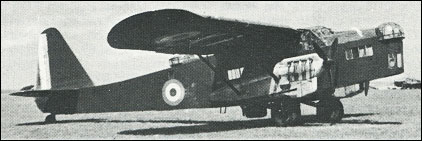|
| Built as a private venture, the Potez 54
M.4 category prototype flew for the first time on 14 November 1933. A multiplace de combat design by Louis Coroller, it was intended as a four-seater capable of
performing duties as escort fighter, bomber or long-range reconnaissance aircraft. Largely of wood construction, the Potez 54 was a high-wing monoplane with twin fins and rudders, powered by two 515kW Hispano-Suiza 12Xbrs V-12 engines in streamlined nacelles which were connected to the fuselage by stub wings. The main landing gear units retracted into the nacelles, and bomb racks were mounted beneath the stub wings. During development the original tailplane was replaced by a single fin and rudder, and in this form the type was re-designated Potez 540 No. 1 and delivered to the Armee de I'Air on 25 November 1934. Parallel with the Potez
540 were developed the Potez 541
prototype, powered by Gnome-Rhone 14Kdrs radials, and the Potez 542 with 537kW Lorraine Petrel engines.
All versions had defensive armament of manually-operated nose and dorsal turrets and a semi-retractable ventral 'dustbin' position; radio, oxygen, night and blind flying equipment were standard, and reconnaissance cameras could be carried.
 | A three-view drawing of Potez 540 (1274 x 804) |
| MODEL | Potez 540 |
| ENGINE | 2 x Hispano-Suiza 12Xirs Vee piston engines, 515kW |
| WEIGHTS |
| Take-off weight | 5950 kg | 13118 lb |
| Loaded weight | 3785 kg | 8345 lb |
| DIMENSIONS |
| Wingspan | 22.1 m | 73 ft 6 in |
| Length | 16.2 m | 53 ft 2 in |
| Height | 3.88 m | 13 ft 9 in |
| Wing area | 76.0 m2 | 818.06 sq ft |
| PERFORMANCE |
| Max. speed | 310 km/h | 193 mph |
| Ceiling | 5182 m | 17000 ft |
| Range | 1250 km | 777 miles |
| ARMAMENT | 3 x 7.5mm machine-guns, 4 x 225kg or 10 x 55kg bombs |
| Klaatu83, e-mail, 24.06.2012 23:55 The "Multiplace de Combat" concept was a throwback to World War I, particularly to the relative success of the Caudron R-11 three-seat escort fighter. The idea of an all-purpose combat plane seemed to hold a great deal of appeal during the cash-strapped 1920s and 1930s, particularly in France. However, it proved to be as difficult in the 1930s to develop an single airplane that could effectively carry out all military missions as it still does today. As the old saying goes, "Jack of all trades and master of none". reply |
|
Do you have any comments?
|
| 
COMPANY
PROFILE
All the World's Rotorcraft
|







